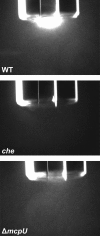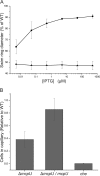Sinorhizobium meliloti chemoreceptor McpU mediates chemotaxis toward host plant exudates through direct proline sensing
- PMID: 24657863
- PMCID: PMC4018860
- DOI: 10.1128/AEM.00115-14
Sinorhizobium meliloti chemoreceptor McpU mediates chemotaxis toward host plant exudates through direct proline sensing
Abstract
Bacterial chemotaxis is an important attribute that aids in establishing symbiosis between rhizobia and their legume hosts. Plant roots and seeds exude a spectrum of molecules into the soil to attract their bacterial symbionts. The alfalfa symbiont Sinorhizobium meliloti possesses eight chemoreceptors to sense its environment and mediate chemotaxis toward its host. The methyl accepting chemotaxis protein McpU is one of the more abundant S. meliloti chemoreceptors and an important sensor for the potent attractant proline. We established a dominant role of McpU in sensing molecules exuded by alfalfa seeds. Mass spectrometry analysis determined that a single germinating seed exudes 3.72 nmol of proline, producing a millimolar concentration near the seed surface which can be detected by the chemosensory system of S. meliloti. Complementation analysis of the mcpU deletion strain verified McpU as the key proline sensor. A structure-based homology search identified tandem Cache (calcium channels and chemotaxis receptors) domains in the periplasmic region of McpU. Conserved residues Asp-155 and Asp-182 of the N-terminal Cache domain were determined to be important for proline sensing by evaluating mutant strains in capillary and swim plate assays. Differential scanning fluorimetry revealed interaction of the isolated periplasmic region of McpU (McpU40-284) with proline and the importance of Asp-182 in this interaction. Using isothermal titration calorimetry, we determined that proline binds with a Kd (dissociation constant) of 104 μM to McpU40-284, while binding was abolished when Asp-182 was substituted by Glu. Our results show that McpU is mediating chemotaxis toward host plants by direct proline sensing.
Figures








Similar articles
-
Sinorhizobium meliloti Chemoreceptor McpV Senses Short-Chain Carboxylates via Direct Binding.J Bacteriol. 2018 Nov 6;200(23):e00519-18. doi: 10.1128/JB.00519-18. Print 2018 Dec 1. J Bacteriol. 2018. PMID: 30201781 Free PMC article.
-
McpT, a Broad-Range Carboxylate Chemoreceptor in Sinorhizobium meliloti.J Bacteriol. 2021 Aug 9;203(17):e0021621. doi: 10.1128/JB.00216-21. Epub 2021 Aug 9. J Bacteriol. 2021. PMID: 34124939 Free PMC article.
-
Contribution of Individual Chemoreceptors to Sinorhizobium meliloti Chemotaxis Towards Amino Acids of Host and Nonhost Seed Exudates.Mol Plant Microbe Interact. 2016 Mar;29(3):231-9. doi: 10.1094/MPMI-12-15-0264-R. Epub 2016 Feb 22. Mol Plant Microbe Interact. 2016. PMID: 26713349
-
Polyamine biosynthesis and biological roles in rhizobia.FEMS Microbiol Lett. 2019 Apr 1;366(7):fnz084. doi: 10.1093/femsle/fnz084. FEMS Microbiol Lett. 2019. PMID: 31062028 Review.
-
Non-Genetic Diversity in Chemosensing and Chemotactic Behavior.Int J Mol Sci. 2021 Jun 28;22(13):6960. doi: 10.3390/ijms22136960. Int J Mol Sci. 2021. PMID: 34203411 Free PMC article. Review.
Cited by
-
Sensory Repertoire of Bacterial Chemoreceptors.Microbiol Mol Biol Rev. 2017 Oct 25;81(4):e00033-17. doi: 10.1128/MMBR.00033-17. Print 2017 Dec. Microbiol Mol Biol Rev. 2017. PMID: 29070658 Free PMC article. Review.
-
Diverse Sensory Repertoire of Paralogous Chemoreceptors Tlp2, Tlp3, and Tlp4 in Campylobacter jejuni.Microbiol Spectr. 2022 Dec 21;10(6):e0364622. doi: 10.1128/spectrum.03646-22. Epub 2022 Nov 14. Microbiol Spectr. 2022. PMID: 36374080 Free PMC article.
-
The Biosynthesis and Functions of Polyamines in the Interaction of Plant Growth-Promoting Rhizobacteria with Plants.Plants (Basel). 2023 Jul 17;12(14):2671. doi: 10.3390/plants12142671. Plants (Basel). 2023. PMID: 37514285 Free PMC article. Review.
-
Chemotactic Host-Finding Strategies of Plant Endoparasites and Endophytes.Front Plant Sci. 2020 Jul 31;11:1167. doi: 10.3389/fpls.2020.01167. eCollection 2020. Front Plant Sci. 2020. PMID: 32849722 Free PMC article. Review.
-
Deciphering Bacterial Chemorepulsion: The Complex Response of Microbes to Environmental Stimuli.Microorganisms. 2024 Aug 18;12(8):1706. doi: 10.3390/microorganisms12081706. Microorganisms. 2024. PMID: 39203548 Free PMC article. Review.
References
-
- Uren NC. 2007. Types, amounts, and possible functions of compounds released into the rhizosphere by soil-grown plants, p 19–40 In Pinton R, Varanini Z, Nannipiero P. (ed), The rhizosphere: biochemistry and organic substances at the soil-plant interface. CRC Press, New York, NY
Publication types
MeSH terms
Substances
LinkOut - more resources
Full Text Sources
Other Literature Sources

